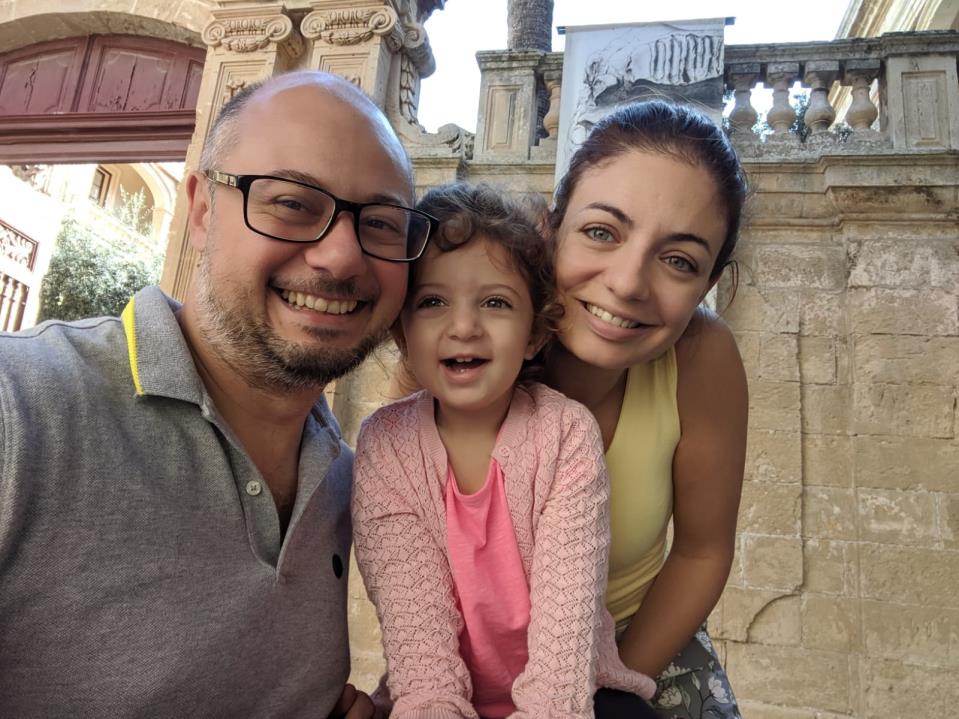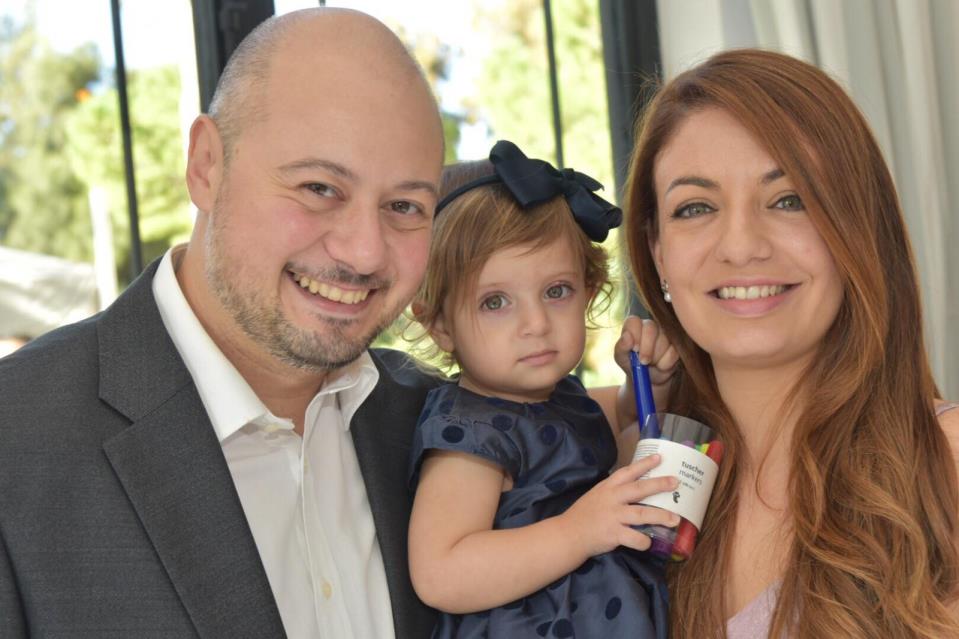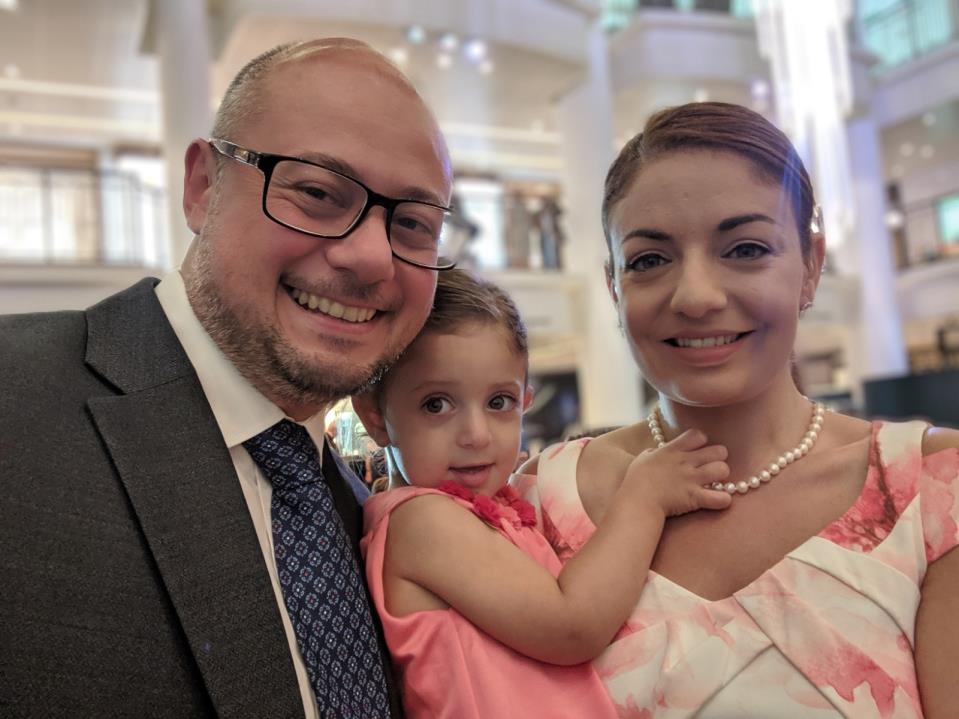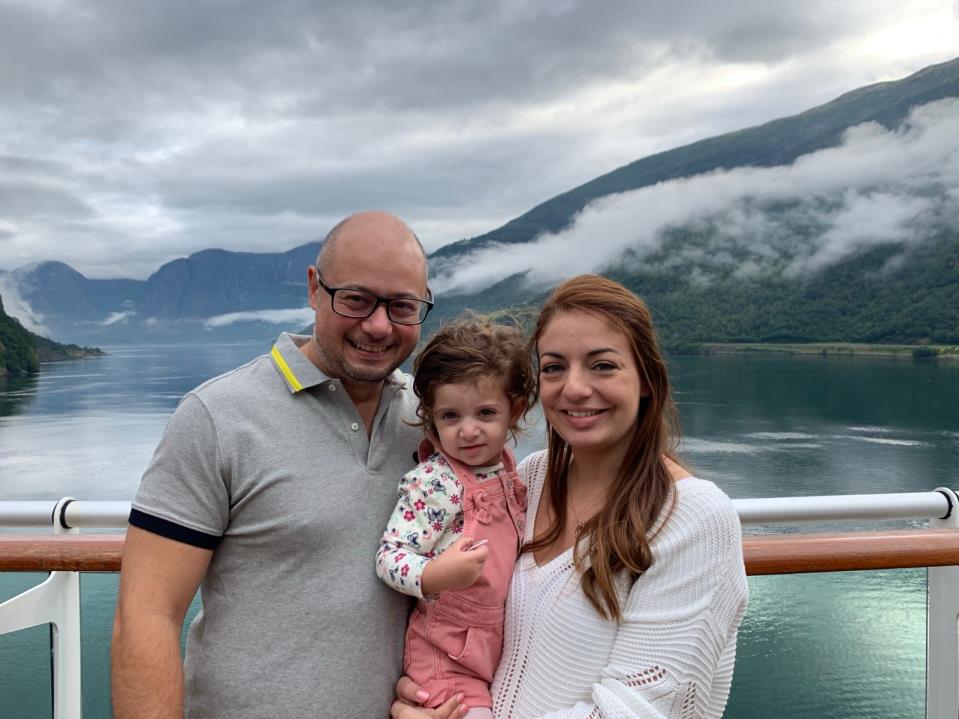“Annabelle and I met in Gozo through mutual friends. We became close friends until she realised that she could not live without me! To tell you the truth, I had to adjust to a new reality with Annabelle, one which I never experienced as a hearing person dating a deaf person. The challenges and experiences in such relationships can somewhat be different from relationships between hearing persons. The best part of our relationship is that we learned to develop our own way of communication, which to me, is something extraordinary.
When Annabelle was pregnant with Emily, I remember her telling me that she was worried that she wouldn’t be able to communicate well with our daughter. Today not only are they inseparable from each other, but Emily tells me to “go away” so that she can have mummy all to herself. Jokes aside, sometimes I am unable to understand our daughter, and it is my wife that understands what she is saying or what she wants.”
Were you concerned your child would also have hearing loss?
The only thing that concerned me was that if deaf, our children would face challenges and stigma. Yet, I have watched Annabelle facing barriers head-on and overcoming stigma, so I knew that if our daughter became deaf, she would have an excellent role model. I am not one least bit concerned about the possibility of our children being deaf, and I am more annoyed at how society creates barriers for the deaf community or at people’s lack of awareness. For example, we were unable to enjoy movies at the cinema as I knew Annabelle wouldn’t be able to follow the film due to lack of subtitles. In fact, during the past couple of years, I was happy to see cinema screening movies with subtitles appearing. I am also tired of being asked by people to tell something to my wife on their behalf. I understand that some people feel anxious speaking to her, as they may not be aware of how to talk to a deaf person - something which can be frustrating for both myself and my wife, as I know this makes her feel invisible or different from the rest.

Did you learn sign language to communicate with your wife and daughter?
My wife and I have our own way to communicate. She depends mainly on lip-reading, and I learned to use visual cues or certain gestures to get her attention, like switching on and off the lights to show her that I arrived home and avoid giving her a scare since she does not hear me coming in. Or for example, my wife dislikes it when she does not realise that someone is still speaking and she unintentionally starts to speak. So we agreed that I would squeeze her arm gently and discreetly, indirectly telling her that someone is still speaking, so that she can wait until the person finishes. Or for example, in the car on our way home, I got used to repeating conversations or discussions which she was unable to follow during our outing. I learned sign language as it helped me to communicate better with my wife, although I use only a few signs when she finds it difficult to lip read—learning how to sign also helped me to be able to communicate with our deaf friends. Still, I need to practice more to be able to be more fluent. It is easy to forget how to sign when you don’t use it often.

How has Emily helped in your situation?
Having a deaf mother is natural for Emily. It makes me happy to see Annabelle teaching Emily how to sign, as I can see that this helps them both to be able to communicate with each other, plus Emily gets to learn another language. As our daughter is starting to speak more, sometimes my wife finds it difficult to understand what our daughter is saying. But Emily surprises us by making an effort to get her message across to her mother, using gestures and body language when she doesn’t know the sign.
When Emily calls out to her mother and Annabelle does not hear her, I remind Emily that her mother is deaf and that she has to get her mother’s attention by tapping her instead of calling her. What Emily does in certain situations is the same thing that any other toddler would do. For example, if Annabelle drops the keys, like any other toddler, Emily would point at the dropped keys. The only difference is that any hearing mother would hear the keys drop, whereas Annabelle does not hear the keys drop and uses Emily’s gestures as signifiers that help her notice that the keys fell.
Emily has become her mother’s ears because it comes naturally for Annabelle to rely on visual cues, gestures and body language. These gestures are taken for granted by other hearing mothers but have become useful for my wife. For example, when ringing a doorbell, any toddler can squeal excitedly when they hear the person at the other end of the doorbell speak. Since Annabelle cannot hear, she waits for her daughter’s happy face as a signifier that someone talked to her from the intercom.
Our daughter was born with a rare condition that can be life-threatening. She almost lost her life due to late diagnosis. She was treated in one of the best children’s hospitals in London, where we spent three nerve-wracking months, silently willing our daughter to live. Losing a child is any parent’s worst nightmare. What we experienced was blood-curdling, and to this day, we both still have nightmares remembering those days and not knowing what the future holds.
Annabelle was finding it difficult to follow everything that the doctors, consultants, and nurses were saying. I am used to repeating and rephrasing for her when she is unable to follow, yet during our time in London, I was finding it very difficult to repeat. For one thing, I was in an awful state of mind, not knowing whether our daughter would live. Moreover, we were receiving one blow after another from the doctors, such as when our daughter’s lungs collapsed, or when she desaturated, or when she had heart failure. I was finding it hard to process these updates and even harder to repeat such bad news, which I knew would hurt my wife. The medical team knew that Annabelle was deaf, and most of them were careful not to speak too fast and ensure that she could lip-read. Yet she was finding it difficult to focus, due to the emotion of the situation. There was also a doctor who even took the time to write everything he was saying so that Annabelle could follow. I was relieved when she finally managed to use the services of sign language interpreters to be able to follow what the doctors were saying,

Do you feel you face any particular stigma for being in your position?
I personally do not face any particular stigma. But I feel uncomfortable when people ask me to say something on their behalf to my wife when she is standing next to me. I instantly have a lot of respect for people who we just met, who make an effort to talk to my wife like a normal human being and not let her be sidetracked when they learn that she is deaf. I understand that people may feel uneasy when they are faced with a disability that they are not accustomed to, but it would be so much easier if they make an effort. Also, sometimes people are surprised that she is deaf and tell me that she does not look like it and that she speaks so well for a deaf person. This can be very annoying, as I don’t know what deaf people are supposed to look like. Even our daughter, who has a rare metabolic condition has no physical signs that show other people that she has such a serious condition. I think this is something that needs to change in society. Many people have the mentality that disability is visible or that having a disability is something negative, forgetting that disabled people are human beings who are capable too.

Do you believe deafness is considered a disability in Maltese society?
Yes, deafness is considered a disability in Malta by society. But when I met with Malta’s deaf community through Annabelle, I started to learn about their deaf culture and realised that they do not consider their deafness to be a disability. They have their own language, and they are proud to be deaf. When I met Annabelle, I learned that she found it difficult to tell people that she is deaf as she disliked being treated differently. After a few years, she met with Malta’s deaf community for the first time, and I watched her change. She learned sign language which changed her life for the better, embraced a deaf identity, and finds it more comfortable to tell people that she is deaf. When she started A Silent World (online blog), I knew how difficult it was for her to say to the world that she is deaf. She has come far since then, revealing lots of potentials, and becoming an excellent role model for many deaf children and adults alike. New parents of deaf children contact her, seeking information or to reach out for a chat. Her main aim is to use her voice and raise awareness, even though this means that she exposes some of our life. But I encourage her to do it because the good she is doing is priceless.
What more can be done in Malta to raise awareness and support for the deaf community?
From what Annabelle tells me and from what I have experienced, more awareness needs to be raised about the importance of sign language, especially for deaf children. Our daughter’s first words were in signs when she was just a few months old. Teaching our daughter how to sign is beneficial for Annabelle to be able to communicate effectively with Emily. If reversed, that is if a baby is deaf and the parents are hearing, it’s even more critical for the child to learn how to sign, to be able to communicate with the parents. If children are born deaf, they may take longer to learn the spoken language and may be unable to communicate. By learning sign language, they can communicate with their parents and eventually learn how to talk too. Language acquisition is essential in the first few years, whether the communication is signed or spoken. Apart from that, sign language is also an opportunity for deaf children and adults alike to have more access to information. Many are afraid to teach sign language to their deaf children, for fear that they would not learn how to speak. But both sign and spoken languages are essential for the deaf - both are recognised languages.
You can follow the blog “A silent world” on Facebook or https://silentworldmalta.wordpress.com